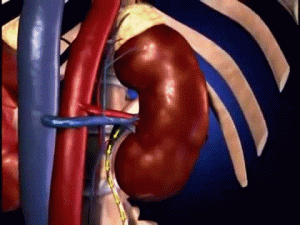
Diabetes insipidus should not be confused with diabetes mellitus (DM) which results from insulin deficiency or resistance leading to high blood glucose also called blood sugar. Diabetes insipidus and diabetes mellitus are unrelated although they can have similar signs and symptoms, like excessive thirst and excessive urination.
Diabetes insipidus(DI) is a rare disease or disorder that causes frequent urination the abnormal large volume of urine which is passed from the kidney. It is usually dilute and odourless. In people with diabetes insipidus, the kidneys can pass 3 to 20 quarts of urine a day. As a result, a person with diabetes insipidus may feel the need to drink large amounts of liquids. People with diabetes insipidus have normal blood glucose levels; however, their kidneys cannot balance fluid in the body.
ROLES OF THE KIDNEYS IN URINE PRODUCTION
The kidneys are two bean-shaped organs, each about the size of a fist located just below the rib cage, each at the side of the spine. However, there is a functional unit of the kidney called nephrone. This is where osmoregulation and selective reabsorption occurs. This selective reabsorption which happens in the Bowman’s capsule filtrate the toxic to be passed with urine. Each day, the kidneys normally filter about 120 to 150 quarts of blood to produce about 1 to 2 quarts of urine, composed of wastes and extra fluid. The urine flows from the kidneys to the bladder through tubes called ureters which is anatomically attached in the trigone region in the bladder from the kidneys. When you urinate (void), urine flows out of the body through a tube called urethra, located at the bottom of the urinary bladder.
PROCESSES OF OSMOREGULATION IN THE BODY/CAUSES OF DI.
While urination (voiding) removes most fluid, dehydration or thirst usually prompts a person’s rate of liquid uptake and removing extra fluid which can pose as a threat if not expelled. People lose fluid through breathing, diarrhea and sweating through the skin. the vasopressin hormone is produced by the hypothalamus which is located at the base of the brain. This vasopressin hormone or antidiuretic hormone (ADH) controls the fluid removal rate through urination. The vasopressin hormone is released into the bloodstream and signals the kidneys to absorb less fluid from the bloodstream when the body has a low fluid level and this results in less urine. The pituitary gland releases smaller amount of vasopressin when the body has extra fluid so that more fluid will be removed by the kidney from the bloodstream and produce more urine.
TYPES OF DIABETES INSIPIDUS
There are 4 types of diabetes insipidus (DI) and this include;
1-Central or neurogenic
2-Nephrogenic
3-Dipsogenic
4-Gestational
NEUROGENIC OR CENTRAL DIABETES INSIPIDUS
This is sometimes called cranial diabetes insipidus. It is a form of DI caused by a problem in the hypothalamus section of the brain. if the Antidiuretic hormone (ADH) isn’t produced, the kidneys will go on producing urine, resulting in frequent trips to the toilet (pis-en-deux) and a higher risk of dehydration. Head injury, brain tumours or brain surgery can all result in damage to the hypothalamus or pituitary gland, which can prevent it from producing and storing the antidiuretic hormone (ADH).
NEPHROGENIC DIABETES INSIPIDUS
There are two forms of nephrogenic diabetes insipidus; congenital and acquired nephrogenic diabetes insipidus.
Congenital – this type of nephrogenic diabetes is present from birth and is caused by several genes that cause the kidneys of the foetus not to form properly. This rogue genes which causes deformations can be passed from unaffected mothers to their sons. this type of diabetes is very rare.
Acquired – this type of diabetes occurs after birth as a result of an outside factor damaging the kidney and leading to excessive voiding or urination. This factors are excessive intake of lithium, infections, blockages (such kidney stone, medically known as Nephrolithiasis)
DIPSOGENIC DIABETES INSIPIDUS
This is a defect in the thirst mechanism which is located in a person’s hypothalamus. It is an abnormal increase in thirst and liquid intake and suppresses vasopressin secretion and increases urine output.
GESTATIONAL DIABETES INSIPIDUS
This type of diabetes occurs only during pregnancy whereby an enzyme made by the placenta breaks down the mother’s vasopressin. Gestational diabetes insipidus usually goes away after the mother delivers the baby and usually comes back during pregnancy.
SYMPTOMS OF DIABETES INSIPIDUS
The most common symptoms of diabetes is frequent urination and the secondary symptom is increased thirst. Others include:
. Cracked skin
. Unconsciousness
. Dizziness
. Fatigue
Children or infants with Diabetes insipidus may have the following symptoms:
. Trouble sleeping
. Fever
. Delayed growth
. Vomiting
. Weight loss.
DIAGNOSIS
Diagnosing diabetes insipidus can be complicated as it shares many symptoms of diabetes mellitus. However, some tests are carried out to know what exactly the patient is suffering from. These include urinalysis, MRI scans, and fluid deprivation.
TREATMENT
Mild cases of CENTRAL diabetes insipidus may not need hormone replacement as hormone replacement is prescribed in form of desmopressin in other cases but this case requires increased water intake.
NEPHROGENIC diabetes insipidus treatment may include:
. (NSAIDs) non-steroidal anti-inflammatory drugs.
. Diuretics.
. Reducing sodium intake and increasing water intake.
However, it is advised that you visit your nutritionist to organize a diet plan.









Thank you.